
PHOTOS FROM THE FARM: 10.11.19
10/11/19 — Ada Broussard
Farm photographer Scott David Gordon got an early start this week and captured pre-dawn eggplant harvests as well as middle of the day transplanting duties. If you look at the pictures below you should notice more sweatshirts than usual. We're loving this cold front!
![]() Vicente's two most used tools - his radio and his harvest log. And of course his hat and his truck... Photo by Scott David Gordon.
Vicente's two most used tools - his radio and his harvest log. And of course his hat and his truck... Photo by Scott David Gordon.
![]() When does a farmers' day get started? About 20 minutes before sunrise, when the day is coolest. Photo by Scott David Gordon.
When does a farmers' day get started? About 20 minutes before sunrise, when the day is coolest. Photo by Scott David Gordon.
![]() Eggplant toss, in the almost-dark. Photo by Scott David Gordon.
Eggplant toss, in the almost-dark. Photo by Scott David Gordon.
![]() Look at how much eggplant our crew harvested before official sunrise! Our harvest trailer makes transportation of heavy harvest bins an easier task. Photo by Scott David Gordon.
Look at how much eggplant our crew harvested before official sunrise! Our harvest trailer makes transportation of heavy harvest bins an easier task. Photo by Scott David Gordon.
![]() It takes a big team to harvest even one single crop! Photo by Scott David Gordon.
It takes a big team to harvest even one single crop! Photo by Scott David Gordon.
![]() Multiplying onions in the ground. We will let these babies size up, and then divide them to plant more onions. Photo by Scott David Gordon.
Multiplying onions in the ground. We will let these babies size up, and then divide them to plant more onions. Photo by Scott David Gordon.
![]() Jack and the John Deere. Photo by Scott David Gordon.
Jack and the John Deere. Photo by Scott David Gordon.
![]() Thai peppers, showing their bellies to the sun. Photo by Scott David Gordon.
Thai peppers, showing their bellies to the sun. Photo by Scott David Gordon.
![]() Thousands (and thousands) of onion transplants in our greenhouse. Photo by Scott David Gordon.
Thousands (and thousands) of onion transplants in our greenhouse. Photo by Scott David Gordon.
![]() Transplants hardening off outside the greenhouses. Photo by Scott David Gordon.
Transplants hardening off outside the greenhouses. Photo by Scott David Gordon.
![]() Bunching sweet potato greens. Photo by Scott David Gordon.
Bunching sweet potato greens. Photo by Scott David Gordon.
![]() The transplanter is all loaded up with fuel and plants... it's just missing two important things. Photo by Scott David Gordon.
The transplanter is all loaded up with fuel and plants... it's just missing two important things. Photo by Scott David Gordon.
 Vicente's two most used tools - his radio and his harvest log. And of course his hat and his truck... Photo by Scott David Gordon.
Vicente's two most used tools - his radio and his harvest log. And of course his hat and his truck... Photo by Scott David Gordon.
 When does a farmers' day get started? About 20 minutes before sunrise, when the day is coolest. Photo by Scott David Gordon.
When does a farmers' day get started? About 20 minutes before sunrise, when the day is coolest. Photo by Scott David Gordon.
 Eggplant toss, in the almost-dark. Photo by Scott David Gordon.
Eggplant toss, in the almost-dark. Photo by Scott David Gordon.
 Look at how much eggplant our crew harvested before official sunrise! Our harvest trailer makes transportation of heavy harvest bins an easier task. Photo by Scott David Gordon.
Look at how much eggplant our crew harvested before official sunrise! Our harvest trailer makes transportation of heavy harvest bins an easier task. Photo by Scott David Gordon.
 It takes a big team to harvest even one single crop! Photo by Scott David Gordon.
It takes a big team to harvest even one single crop! Photo by Scott David Gordon.
 Multiplying onions in the ground. We will let these babies size up, and then divide them to plant more onions. Photo by Scott David Gordon.
Multiplying onions in the ground. We will let these babies size up, and then divide them to plant more onions. Photo by Scott David Gordon.
 Jack and the John Deere. Photo by Scott David Gordon.
Jack and the John Deere. Photo by Scott David Gordon.
 Thai peppers, showing their bellies to the sun. Photo by Scott David Gordon.
Thai peppers, showing their bellies to the sun. Photo by Scott David Gordon.
 Thousands (and thousands) of onion transplants in our greenhouse. Photo by Scott David Gordon.
Thousands (and thousands) of onion transplants in our greenhouse. Photo by Scott David Gordon.
 Transplants hardening off outside the greenhouses. Photo by Scott David Gordon.
Transplants hardening off outside the greenhouses. Photo by Scott David Gordon.
 Bunching sweet potato greens. Photo by Scott David Gordon.
Bunching sweet potato greens. Photo by Scott David Gordon.
 The transplanter is all loaded up with fuel and plants... it's just missing two important things. Photo by Scott David Gordon.
The transplanter is all loaded up with fuel and plants... it's just missing two important things. Photo by Scott David Gordon.
HOMEMADE GNOCCHI
10/09/19 — Ada Broussard
 For an afternoon when you have time to experiment, give homemade gnocchi a try. The Migoni Kitchen sets you up for success in the recipe below.
For an afternoon when you have time to experiment, give homemade gnocchi a try. The Migoni Kitchen sets you up for success in the recipe below.
Homemade Potato Gnocchi
Author: The Migoni Kitchen Servings: 5 People Total Time: 50 minutesIngredients
- 3 Large potatoes, unpeeled
- 2 Cups All-purpose flour - May need a little extra for rolling the gnocchi
- 1 Large Egg
- 5 Tbsp Kosher salt
- 2 Tbsp olive oil
 Homemade gnocchi perfection.
Homemade gnocchi perfection.
- Fill a large pot with water and bring to a boil. Add 2 tablespoons kosher salt.
- Wash potatoes, but do not peel. Once the water is boiling, place potatoes in the water, and allow them to cook for at least 20 minutes.
- After 20 minutes test the potatoes to see if they are done. You should be able to easily press a fork to the center of the potato without breaking it. If potatoes are still firm, allow the potatoes to continue cooking until done.
- Remove potatoes from the water and allow to cool. Once they are cool enough to handle, peel the skin off of the potatoes. Using a potato masher (or ricer), mash the potatoes in a large deep pan.
- Measure 1.5 cups of flour and sprinkle it on top of the mashed potato, along with 1 tablespoon salt.
- Create a small well in the middle of the flour and potato mixture, and break the egg in the middle of the well. Begin beating the egg with a fork to begin incorporating the flour.
- Use your hands to knead the potato, flour, and egg mixture into a dough. As you knead, add additional flour, as needed, until the dough is no longer sticky. You want a soft dough, that is easy to roll, but firm enough to retain a shape.
- Once you have obtained the desired consistency, roll the dough out into a wide rectangle. Using a sharp knife, cut 6-8 slices about 2 inches thick.
- On a lightly floured surface, roll each slice of dough into a long rope, about 1 inch thick. Use your knife again to begin cutting segments of the dough, about 1 inch long.
- Gently press and roll each segment of dough over the back of a large fork. This creates the traditional gnocchi "look". After rolling, lay your finished gnocchi out on a floured surface and sprinkle additional flour as needed to avoid sticking.
- Fill a large pot with at least 4 quarts of water and add the 2 remaining tablespoons of salt. Place water over high heat and allow to boil.
- Once the water has begun boiling, add half of the batch of gnocchi. The gnocchi will begin to rise to the top of the water when they are fully cooked. Begin skimming them out of the water and placing them into a separate pan.
- Once you have removed all of the gnocchi, you may begin cooking the second batch. Drizzle olive oil over the cooked gnocchi to prevent them from sticking until served.
- Serve with your favorite sauce or simply with some butter and Parmesan!
Notes
- The reason we like to boil the potatoes with the skin on, is because it prevents the potatoes from absorbing as much water. The less water the potatoes absorb, the better texture your gnocchi will have. You also want to avoid over cooking the potatoes, as they will become more mushy. The moral of the story is Watery Potato = Bad Gnocchi.
- I have read several articles that suggest peeling and mashing the potato as quickly as possible after removing them from the water. Supposedly, the hotter the potato is when you make the gnocchi, the fluffier the gnocchi will turn out. While this is an interesting thought, I have not read anything conclusive or scientific to justify this line of thought. We always simply wait until the potatoes are cool enough to handle without burning ourselves. No need for any fancy heat resistant gloves!
- The more flour you add to your gnocchi, the more dense they become. To avoid eating a hard or chewy piece of pasta, always aim to add less flour than anticipated, and add a little at a time as needed. This will ensure you maintain an adequate ratio of flour to potato. Additionally, try not to overwork the dough - the more you knead the dough, the less fluffy it becomes.
 Bon appetit!
Bon appetit!CSA BOX CONTENTS WEEK OF OCT 7TH
10/08/19 — Scott
 CSA Box Contents Week of Oct 7th
CSA Box Contents Week of Oct 7th
Large Box
Beets
Bok Choy
Cucumber
Eggplant
Greens, Collards
Greens, Kale, Curly
Herb, Basil
Lettuce, Braising Mix
Okra
Pepper, Sweet
Potato, Sweet
Radish, Purple Daikon
Turnip, White Japanese
Beets
Bok Choy
Cucumber
Eggplant
Greens, Collards
Greens, Kale, Curly
Herb, Basil
Lettuce, Braising Mix
Okra
Pepper, Sweet
Potato, Sweet
Radish, Purple Daikon
Turnip, White Japanese
Medium Box
Bok Choy
Carrot, Orange
Cucumber
Greens, Arugula
Greens, Collards
Greens, Kale, Curly
Herb, Cilantro
Pepper, Sweet
Potato
Radish, Purple Daikon
Bok Choy
Carrot, Orange
Cucumber
Greens, Arugula
Greens, Collards
Greens, Kale, Curly
Herb, Cilantro
Pepper, Sweet
Potato
Radish, Purple Daikon
Small Box
Greens, Kale, Curly
Herb, Basil
Lettuce, Braising Mix
Okra
Pepper, Sweet
Potato
Turnips
Greens, Kale, Curly
Herb, Basil
Lettuce, Braising Mix
Okra
Pepper, Sweet
Potato
Turnips
Individual Box
Eggplant
Greens, Arugula
Greens, Kale, Curly
Okra
Potato, Sweet
Eggplant
Greens, Arugula
Greens, Kale, Curly
Okra
Potato, Sweet
TOP 5 CSA VEGETABLES
10/04/19 — Ada Broussard

FALL CSA PROMOTION ALERT FOR NEW CSA MEMBERS:
Join the CSA before the end of October and get vegetables delivered to your home (or office) for free for four weeks. Signup here and enter HOME at checkout.
It’s fall, technically, but we all know it’s still hot outside. The vegetables that are making their way into our CSA shares right now are reflective of this juxtaposition- summer crops are still hanging on, but fall crops are starting to creep in, announcing their presence like the cool new kid at school: confident, fresh, and a welcome change to the usual suspects. For farmers and CSA Members alike, this transitional moment in the season equates to a bounty of variety - you’re getting the best of all the Texas seasons… in one box!
Choosing a favorite vegetable is akin to choosing a favorite child. It’s hard, and not a perfect process, but for one reason or another, depending on the day, you may just have a couple favorites. The vegetables listed below are our top picks for CSA vegetables right now. It may change in a week or so when cucumbers are being difficult, but our top picks this week are: white Japanese turnips, collard greens, cucumbers, parsley, and sweet potatoes. We’ve chosen these vegetables for a myriad of reasons - either because they’re a reliable and accessible pack of flavor and nutrition, or because we think they’re underrated and deserve the spotlight.
1. White Japanese Turnips
If you’re not yet on the white Japanese (or salad) turnip train, please hop on. It’s a juicy, sweet, and versatile trip. These are indubiously one of our favorite vegetables right now. The white bulbs of this vegetable are so tender and juicy; biting through the thin skin into the tender root is more similar to taking a bite out of an apple versus a hard, crunchy carrot. We absolutely adore these eaten raw (seriously, it’s a snack we can’t get enough of), but they’re also great in a quick saute or in a cheesy, baked gratin. If you find these in your CSA share bunched, please don’t throw out those greens: the spicy and fresh tops of these turnips are another reason why they made our favorite list. From root to stem, the whole plant is edible. Two (delicious) vegetables, in one. Post harvest, per rinse.
Post harvest, per rinse.
2. Collards
This may seem like an odd choice, but we can’t get enough of our collards. You know everyone’s obsession with kale? We feel this way about collard greens. And believe it or not, you can use collards in just about any recipe that calls for kale… and then some. When tossed in a screaming hot pan with garlic and ginger and then doused with a bit of soy sauce, collards are the perfect vehicle for any Asian flavors. Travel to India and make a collard saag paneer. When slowly stewed with bacon and onions, collard’s silky texture sops up that savory goodness and begs to be topped by a buttery square of cornbread. Looking to add a nutritional punch to some scrambled eggs or a big stew pot? Think outside the frozen spinach block, and throw in some chopped collard greens, instead. Perhaps the most exciting use of large collard greens might be that of wrapper. Thanks recipe developer, Mackenzie Smith, for showing us the way. Recipe & Photo by Mackenzie Smith.
Recipe & Photo by Mackenzie Smith.
3. Cucumbers
These refreshing cucurbits are the perfect vegetable to carry us through this never ending summer. If it’s too soon for you to stew collards, consider muddling cucumbers with mint, some sugar, and a bit of gin. Sliced cucumbers, tossed with some acid and a bit of salt, are the easiest dish to whip up to balance a meal that’s on the heavy side. At this time in the season, cucumber skin can become somewhat bitter, so if that’s not your thing, remember to stripey peel them. And if you’re reading this thinking about how you are actually sick of cucumbers, please: don’t let them wither in your produce drawer. Do you future self a favor, slice them up, and make some quick pickles. A crunchy, cool, and pickled cucumber in the middle of that inevitable hot Texas winter day will be such a joy. Or, just make this cold soba noodle salad.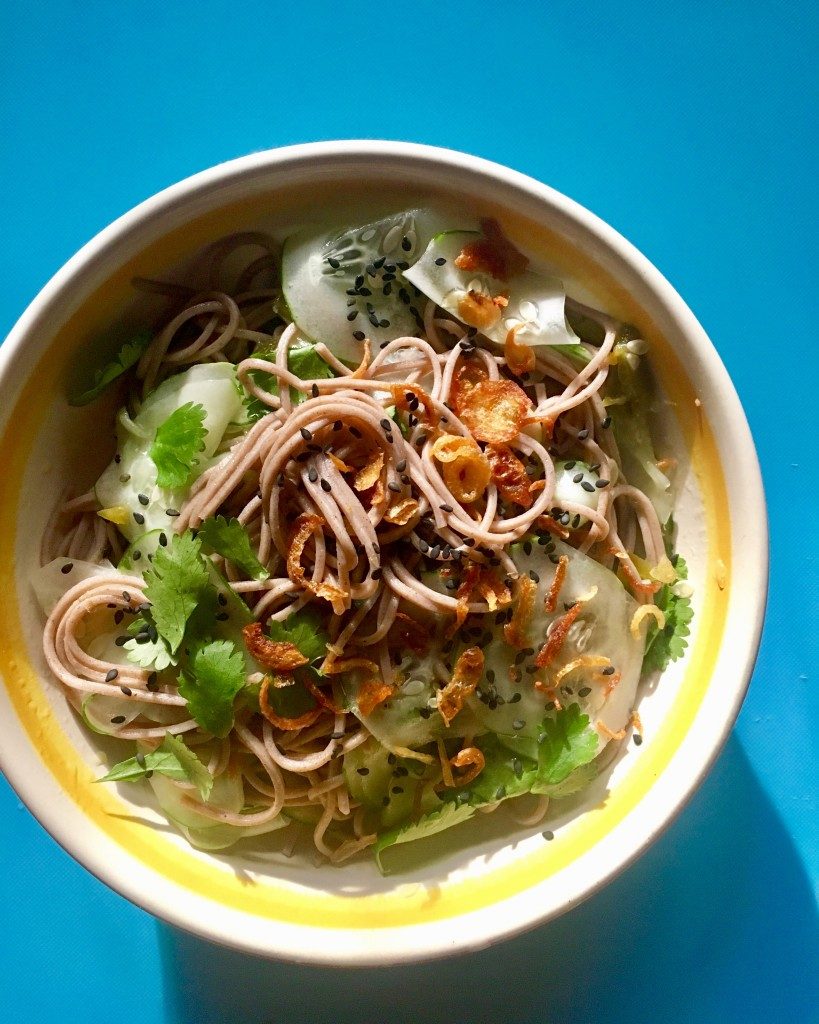 Recipe and Photo by Mackenzie Smith.
Recipe and Photo by Mackenzie Smith.
4. Parsley
We’re aiming to ignite a revolution with this one. Many of you may think of parsley as an herb, something to be sprinkled on top of grilled fish, and while it is just that, it’s so much more. Parsley is underrated. A bunch of parsley in your CSA box is a bunch of fun. Experiment with chopping up the entire bunch, stems and all, and adding it to your next salad, grain bowl, or pasta dish. Middle eastern cuisine makes use of this herb almost like a vegetable that can stand alone, and more is often better. Tabbouleh is of course the classic parsley salad, but a prominent-parsley strategy can be used in many dishes to add a punch of green and herby freshness. Blend it up with some oil, garlic, and salt (at least) for a simple herbed-oil, or load up that blender with parsley, peppers, lemon juice, other herbs like cilantro and dill, as well as some onions and garlic, for a hearty chimichurri (which is incredibly apt at being frozen, and then surprising the most boring of dinner plates with a wham of green punch). Juice it, smoothie it, salad it, soup it…. Whatever you do, don’t toss it. Stems, when finely died, are a great moment of crunch in a taco or an omelet.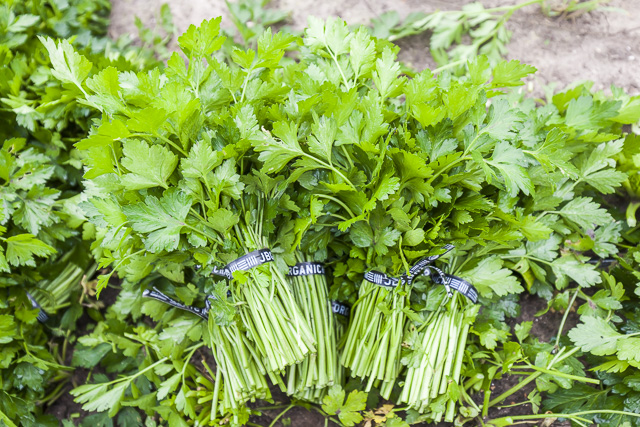 So fresh and so green. Photo by Scott David Gordon.
So fresh and so green. Photo by Scott David Gordon.
5. Sweet potatoes
Sweet potatoes are an easy choice. In Texas, their arrival always marks the transition from summer to fall (they’re a late summer crop), and they usually come to the scene just in time for the eggplant and okra anarchy. What’s not to love about a sweet potato? Roast ‘em, boil ‘em, heck… you can even microwave them for all we care, and then top them with whatever your heart desires for a full meal. Ideally this occasionally includes the classic baked potato toppings like green onions, sour cream, butter, and bacon. Sweet potatoes are more nutritionally dense than white potatoes, and you can make use of them in things like mashes, soups, hashes, or fries. Cut them in rustic wedges, toss with oil and spices, and roast until crispy for home-style wedges. Use sweet potato puree to make pancakes, pies, or bread. They even make an excellent treat for fido.
ARUGULA & PURPLE DAIKON RADISH POTATO SALAD
10/03/19 — Ada Broussard

Recipe by Isaac Winburne and Heydon Hatcher
The arugula and purple daikon radishes bring the zing in this spicy spin on the traditional potato salad. Swapping ingredients is a must and such a fun flavor experiment when you have beautiful, bright, bi-weekly, seasonal ingredients from JBG. When we opened our box to find a bag of our favorite peppery greens and those piquant purple root stunners, we couldn’t wait to augment our potato side with some pizazz AND vibrant beauty to boot. This particular recipe uses a bevy of ingredients from the CSA box - and as seasoned CSA members, honestly, what more could you ask for! We like to think of this as fall’s tribute to a summer staple, as the days get shorter and shorter and **hopefully** the temps get colder and colder.
Ingredients
- 6 boiled potatoes
- 3 boiled eggs
- 2 purple daikon radishes, sliced paper thin
- 2 Claussen kosher dill spears, cut in half and chopped finely
- A quarter of a small red onion, thinly diced
- Handful of arugula, coarsely chopped
- 1 green onion, thinly chopped
- 1 clove of garlic, minced
- 1 lemon
- Spoonful of Claussen pickle juice
- Salt
- Pepper
- Extra virgin olive oil


Boil the potatoes in lightly salted water (amount of salt up to you, lots of folks have lots of differing opinions about this!) until they are soft, about 20-25 minutes. Test with a fork - it should easily pierce the potato. Boil three eggs for about 9 minutes. Throw potatoes and eggs into an ice bath to cool down.
Prepare the purple daikon radishes, garlic, red onion, arugula, green onion, dill pickle spears, and set aside.
When the potatoes and eggs are properly cooled, skin and cube the potatoes. Peel and cube the eggs.
Combine all ingredients and gently toss. While gently tossing, add a healthy drizzle of EVOO, the juice of an entire lemon, a generous helping of salt and pepper, and a spoonful of pickle juice.
ENJOY! It will be even better the next day after spending the night in the fridge, trust us. Cheers.
CSA BOX CONTENTS WEEK OF SEPT 30TH
09/30/19 — Scott
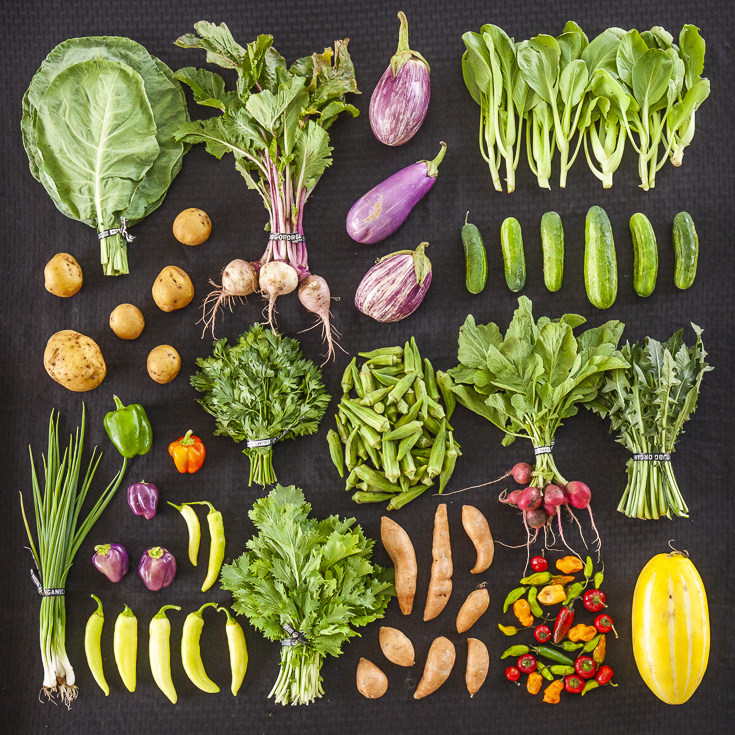 CSA Box Contents Week of Sept 30th
CSA Box Contents Week of Sept 30th
Large Box
Cucumber
Eggplant
Greens, Arugula
Greens, Collards
Greens, Mizuna
Kohlrabi, Purple
Melon, Korean
Okra
Onion, Multiplying
Pepper, Sweet
Potato
Radish, Red
Cucumber
Eggplant
Greens, Arugula
Greens, Collards
Greens, Mizuna
Kohlrabi, Purple
Melon, Korean
Okra
Onion, Multiplying
Pepper, Sweet
Potato
Radish, Red
Medium Box
Bok Choy, Baby
Cucumber
Eggplant
Greens, Collards
Herb, Basil
Melon, Korean
Okra
Onion, Multiplying
Pepper, Sweet
Radish, Red
Bok Choy, Baby
Cucumber
Eggplant
Greens, Collards
Herb, Basil
Melon, Korean
Okra
Onion, Multiplying
Pepper, Sweet
Radish, Red
Small Box
Bok Choy, Baby
Cucumber
Eggplant
Greens, Mizuna
Herb, Basil
Radish, Red
Turnips
Bok Choy, Baby
Cucumber
Eggplant
Greens, Mizuna
Herb, Basil
Radish, Red
Turnips
Individual Box
Cucumber
Greens, Collards
Potato
Radish, Red
Turnips
Cucumber
Greens, Collards
Potato
Radish, Red
Turnips
BRENTON TELLS ALL
09/27/19 — Ada Broussard
This week on the blog we sat down with Farmer Brenton and answered some of your burning questions for him. Thanks to everyone who contributed questions via our Instagram!
![]()
What is the easiest vegetable to grow in Austin? I was just reading an article from Johnny’s seeds that ranks winter vegetables in tiers according to how easy/difficult they are to grow. I would have to say that kale is a pretty reliable and easy vegetable to grow. It's real hardy to cold and holds up to insects and disease. Yep, kale is easy. Except for when it fails to drop 100 degrees.
Have you ever tried to trick something into growing in Texas and failed/succeeded? Well we have to do this every year in the fall! All of our fall transplants are actually germinated in our cooler - lettuce, parsley, fennel, rutabaga, we germinate most of this in our cooler. Even some of the onions and leeks would probably benefit from this, but we don’t quite have the space.
![]() Tomatoes in the greenhouse. Farmers in winter gear. A trick, of sorts!
Tomatoes in the greenhouse. Farmers in winter gear. A trick, of sorts!
What was your favorite thing about going to school at Auburn? war eagle! I thought it was a really pretty town. I remember living there as a young kid when my dad was going to college, and so there was definitely a part of me that was nostalgic to go to the school where my dad went to. I also loved what a small town it was. My bike was my main form of transportation then. I had the bus then, but I mostly bike everywhere, and when I needed to I could just throw the bike in he bus.
How do you decide what to grow? Is there anything you wish you had a longer growing season for? Well, I’m sure some of you wished we had a shorter growing season for eggplant, peppers, and okra. But to answer your question, I wish we could grow tomatoes all summer long like most places north of us. It would also be nice to have a longer season for green beans - their planting window is just so narrow. How we decide what vegetables to grow is a good question.. It’s based on experience of what varieties we know will do well, but it’s also based on things like what I like to cook. How much we plant is also based on our anticipated and predicted demand (which again, is based on experience and data from previous years)... basically, based on what we know will be successful. A whole bunch of what we grow, though, is based on what gets me excited. This summer, for example, we grew so many peppers like Carolina reapers, as well as 4 varieties of Thai chilies. Why be a farmer if you don’t grow the things you’re excited about? Over the years we’ve gained a better understanding of what we can grow, when, with decreased risk. Even though parsnips are a crowd-pleaser, we’ve cut those out of our crop plan because of experience. Strawberries, too. Our soil and water aren’t quite right for strawberries.
if you weren't a farmer, what could you imagine yourself be doing? Well, I love to run, sail, surf, cook, and travel. I think I would like to take an RV trip around the United States and then I could imagine having a sail boat and cruising around the world. Doesn’t that sound fun? Does that answer your question?
![]()
![]() Young Farmer Brenton and his beloved VW bus.
Young Farmer Brenton and his beloved VW bus.
What was the last thing you cooked? Jambalaya! It was awesome. I'm real picky about my sausage. In Alabama, it's very easy to find good tasting, flavorful, hickory smoked sausage, but I feel like I have trouble finding the sausage I want in Texas. My favorite place to get sausage is Fiesta, believe it or not. They bring in sausage from Alabama! I put Conecuh sausage in this jambalaya. Started with the trinity, plus some extra JBG jalapenos. Even though the recipe doesn’t call for jalapenos, I can’t help myself. I also added some JBG parsley and green onions. I usually make a traditional Cajun (versus Creole) jambalaya and don’t use tomatoes, but this time I decided to make a sort of hybrid pot of jambalayas. I couldn’t bring myself to add in the cans of crushed tomatoes like the recipe called for, but I did add in and pince some tomato paste along with my browning vegetables. I love cooking this way - a big pot of something that lends itself to lots of improvisation and hearty leftovers.
![]()
On the days when you love being a farmer - why is that? It’s the days when we work our butts off all day long, and the sense of satisfaction that comes with seeing what we accomplished over the day/week. Farming has very tangible rewards. Fall planting (like, right now) is usually a time when it’s really satisfying to be a farmer. My other favorite time of the year to be a farmer is in the spring - planting season also. A farmer during these periods can imagine and have so much hope about the bounty to come. Plants are healthy and the fields beautifully prepped. Something interesting about farmers.. You have to have so much optimism! Planting is an optimistic time.
On the days when you dislike being a farmer - why is that? It's easy to be overwhelmed with equipment breakdowns, staffing issues, the weather… so many things outside of your control. There are some days when they all seem to pile up and that feeling of optimism is harder to find. I never really imagined how complex it can all be. When everything is going smoothly, you don't think about how complex all the systems are, but when one employee quits or when one insect descends, it’s not always an easy fix to remedy the problem. You can leave the farm one afternoon to beautiful crops, and return the next morning to find worms have ravaged everything. Or like when you leave the farm one day and return to a 2-acre gully. Or when you go home and then tornados flatten all your greenhouse. Or floods. Or freezing temperatures. Wind, too, can be incredibly damaging to crops. Or when you realize the compost you’re using is also introducing new weeds to the property. We have about 5 new grass and weed species on the farm, including a really aggressive strain of amaranth/pig weed, purslane, crabgrass. Just yesterday, the irrigation system broke down and we had to do an emergency repair.Yeah, those kind of things.
How will climate change impact the types of produce that we can grow locally? Well, it seems that this year it's been usually warm later in the season. As I'm writing this, the heat index is at 101... and it's almost October. This year, we actually had a large amount of crop failures in the fall due to excessive heat. Our early season cabbage, cauliflower, broccoli, and kale all died due to the heat. Some things have been better. Wetter weather means more mildew, but due to this summer’s hot and dry conditions, we’ve had little to no problem with powdery mildew. When you have temps that are over 100 degrees, it's also harder to work in the heat. Plants are more stressed, and employees simply can’t work the same hours as seasons when it’s cooler. Thankfully we have a great irrigation system and a powerful ice machine. Even though this summer was hotter than usual, the spring that preceded it was unusually cool.
What varieties of sweet potatoes do you grow? We grow a few different varieties - the orange skinned variety is a beauregard. It's one of the most popular varieties in the south! We also grow a red skinned variety that is burgundy; that one is really popular in California.
When are you opening the farm stand on Highway 71? That project is on hold at the moment, but for now we have CSA pickup at the farm that is just off of HIghway 71. There is also one at Live Oak Brewery on Sundays, which is also just off of HIghway 71.
Did you ever expect that you would become a farmer? Not in my wildest dreams. I was always more into building things (like skateboard ramps) or into my high school yard business… I did like making things and being an entrepreneur, but had no idea that would turn me into a farmer. But now that I've been doing it for 15 years, that I have so much respect for the profession. It's incredibly demanding, but incredibly rewarding. I'm really happy I fell into farming and that I was fortunate to start farming in Austin. I'm really thankful to have a community that values local food and organic agriculture. With all the adversity we face over the years, we've always felt supported and embraced by the community. Thank you!
![]()
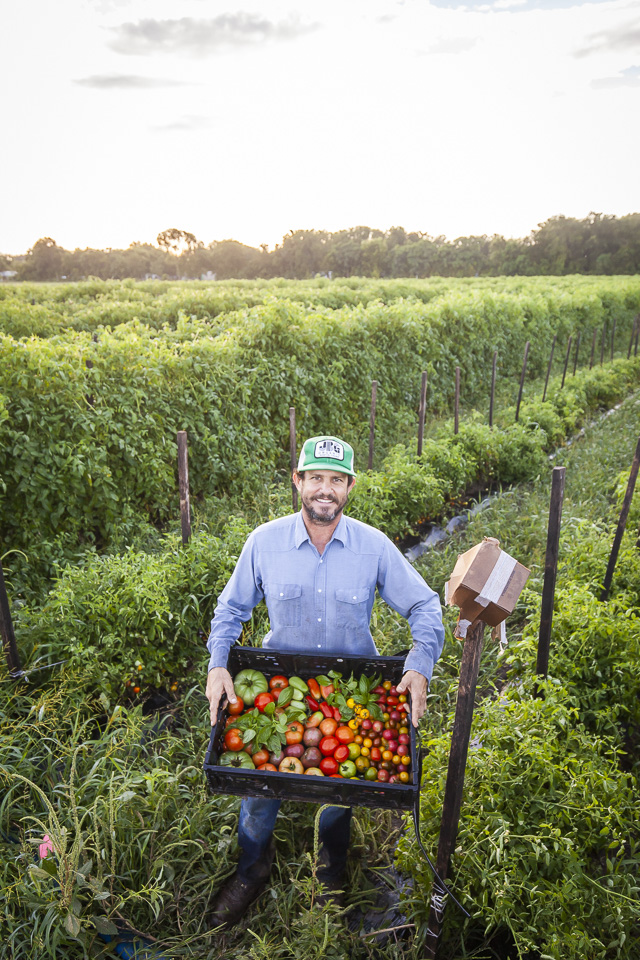
What is the easiest vegetable to grow in Austin? I was just reading an article from Johnny’s seeds that ranks winter vegetables in tiers according to how easy/difficult they are to grow. I would have to say that kale is a pretty reliable and easy vegetable to grow. It's real hardy to cold and holds up to insects and disease. Yep, kale is easy. Except for when it fails to drop 100 degrees.
Have you ever tried to trick something into growing in Texas and failed/succeeded? Well we have to do this every year in the fall! All of our fall transplants are actually germinated in our cooler - lettuce, parsley, fennel, rutabaga, we germinate most of this in our cooler. Even some of the onions and leeks would probably benefit from this, but we don’t quite have the space.
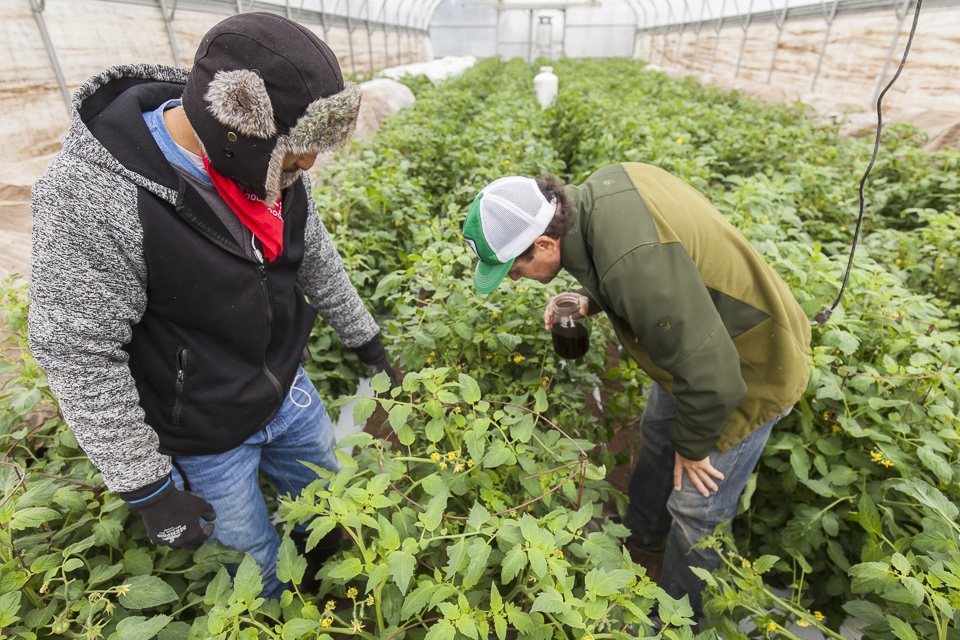 Tomatoes in the greenhouse. Farmers in winter gear. A trick, of sorts!
Tomatoes in the greenhouse. Farmers in winter gear. A trick, of sorts!
What was your favorite thing about going to school at Auburn? war eagle! I thought it was a really pretty town. I remember living there as a young kid when my dad was going to college, and so there was definitely a part of me that was nostalgic to go to the school where my dad went to. I also loved what a small town it was. My bike was my main form of transportation then. I had the bus then, but I mostly bike everywhere, and when I needed to I could just throw the bike in he bus.
How do you decide what to grow? Is there anything you wish you had a longer growing season for? Well, I’m sure some of you wished we had a shorter growing season for eggplant, peppers, and okra. But to answer your question, I wish we could grow tomatoes all summer long like most places north of us. It would also be nice to have a longer season for green beans - their planting window is just so narrow. How we decide what vegetables to grow is a good question.. It’s based on experience of what varieties we know will do well, but it’s also based on things like what I like to cook. How much we plant is also based on our anticipated and predicted demand (which again, is based on experience and data from previous years)... basically, based on what we know will be successful. A whole bunch of what we grow, though, is based on what gets me excited. This summer, for example, we grew so many peppers like Carolina reapers, as well as 4 varieties of Thai chilies. Why be a farmer if you don’t grow the things you’re excited about? Over the years we’ve gained a better understanding of what we can grow, when, with decreased risk. Even though parsnips are a crowd-pleaser, we’ve cut those out of our crop plan because of experience. Strawberries, too. Our soil and water aren’t quite right for strawberries.
if you weren't a farmer, what could you imagine yourself be doing? Well, I love to run, sail, surf, cook, and travel. I think I would like to take an RV trip around the United States and then I could imagine having a sail boat and cruising around the world. Doesn’t that sound fun? Does that answer your question?

 Young Farmer Brenton and his beloved VW bus.
Young Farmer Brenton and his beloved VW bus.
What was the last thing you cooked? Jambalaya! It was awesome. I'm real picky about my sausage. In Alabama, it's very easy to find good tasting, flavorful, hickory smoked sausage, but I feel like I have trouble finding the sausage I want in Texas. My favorite place to get sausage is Fiesta, believe it or not. They bring in sausage from Alabama! I put Conecuh sausage in this jambalaya. Started with the trinity, plus some extra JBG jalapenos. Even though the recipe doesn’t call for jalapenos, I can’t help myself. I also added some JBG parsley and green onions. I usually make a traditional Cajun (versus Creole) jambalaya and don’t use tomatoes, but this time I decided to make a sort of hybrid pot of jambalayas. I couldn’t bring myself to add in the cans of crushed tomatoes like the recipe called for, but I did add in and pince some tomato paste along with my browning vegetables. I love cooking this way - a big pot of something that lends itself to lots of improvisation and hearty leftovers.
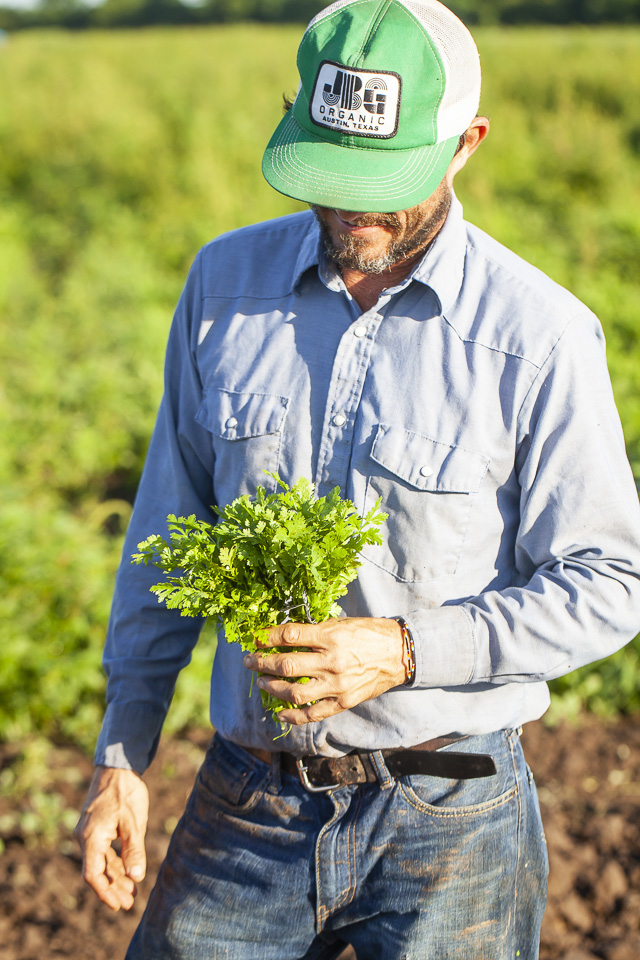
On the days when you love being a farmer - why is that? It’s the days when we work our butts off all day long, and the sense of satisfaction that comes with seeing what we accomplished over the day/week. Farming has very tangible rewards. Fall planting (like, right now) is usually a time when it’s really satisfying to be a farmer. My other favorite time of the year to be a farmer is in the spring - planting season also. A farmer during these periods can imagine and have so much hope about the bounty to come. Plants are healthy and the fields beautifully prepped. Something interesting about farmers.. You have to have so much optimism! Planting is an optimistic time.
On the days when you dislike being a farmer - why is that? It's easy to be overwhelmed with equipment breakdowns, staffing issues, the weather… so many things outside of your control. There are some days when they all seem to pile up and that feeling of optimism is harder to find. I never really imagined how complex it can all be. When everything is going smoothly, you don't think about how complex all the systems are, but when one employee quits or when one insect descends, it’s not always an easy fix to remedy the problem. You can leave the farm one afternoon to beautiful crops, and return the next morning to find worms have ravaged everything. Or like when you leave the farm one day and return to a 2-acre gully. Or when you go home and then tornados flatten all your greenhouse. Or floods. Or freezing temperatures. Wind, too, can be incredibly damaging to crops. Or when you realize the compost you’re using is also introducing new weeds to the property. We have about 5 new grass and weed species on the farm, including a really aggressive strain of amaranth/pig weed, purslane, crabgrass. Just yesterday, the irrigation system broke down and we had to do an emergency repair.Yeah, those kind of things.
How will climate change impact the types of produce that we can grow locally? Well, it seems that this year it's been usually warm later in the season. As I'm writing this, the heat index is at 101... and it's almost October. This year, we actually had a large amount of crop failures in the fall due to excessive heat. Our early season cabbage, cauliflower, broccoli, and kale all died due to the heat. Some things have been better. Wetter weather means more mildew, but due to this summer’s hot and dry conditions, we’ve had little to no problem with powdery mildew. When you have temps that are over 100 degrees, it's also harder to work in the heat. Plants are more stressed, and employees simply can’t work the same hours as seasons when it’s cooler. Thankfully we have a great irrigation system and a powerful ice machine. Even though this summer was hotter than usual, the spring that preceded it was unusually cool.
What varieties of sweet potatoes do you grow? We grow a few different varieties - the orange skinned variety is a beauregard. It's one of the most popular varieties in the south! We also grow a red skinned variety that is burgundy; that one is really popular in California.
When are you opening the farm stand on Highway 71? That project is on hold at the moment, but for now we have CSA pickup at the farm that is just off of HIghway 71. There is also one at Live Oak Brewery on Sundays, which is also just off of HIghway 71.
Did you ever expect that you would become a farmer? Not in my wildest dreams. I was always more into building things (like skateboard ramps) or into my high school yard business… I did like making things and being an entrepreneur, but had no idea that would turn me into a farmer. But now that I've been doing it for 15 years, that I have so much respect for the profession. It's incredibly demanding, but incredibly rewarding. I'm really happy I fell into farming and that I was fortunate to start farming in Austin. I'm really thankful to have a community that values local food and organic agriculture. With all the adversity we face over the years, we've always felt supported and embraced by the community. Thank you!
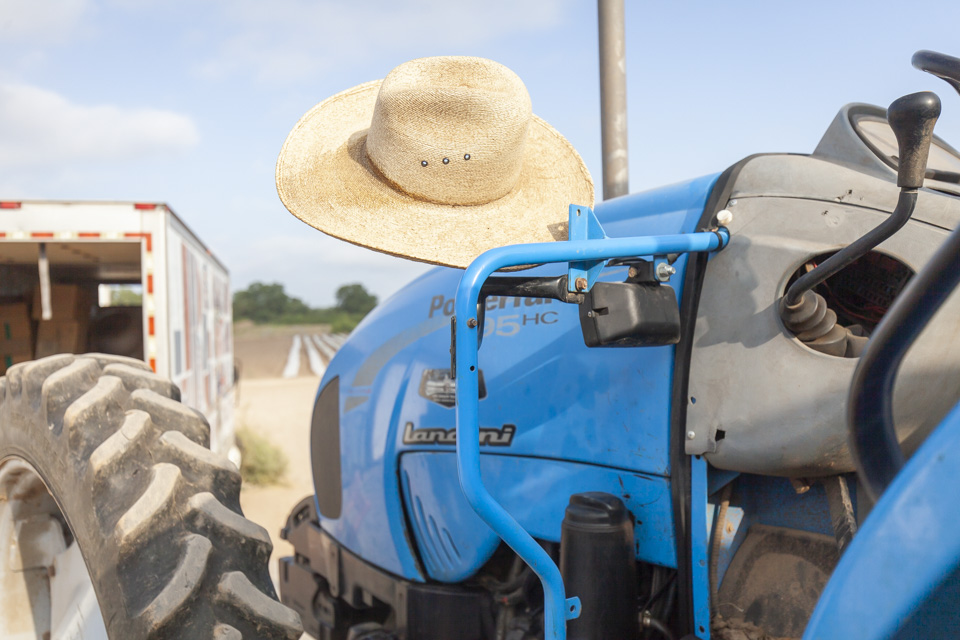






 0 ITEMS IN CART
0 ITEMS IN CART 

